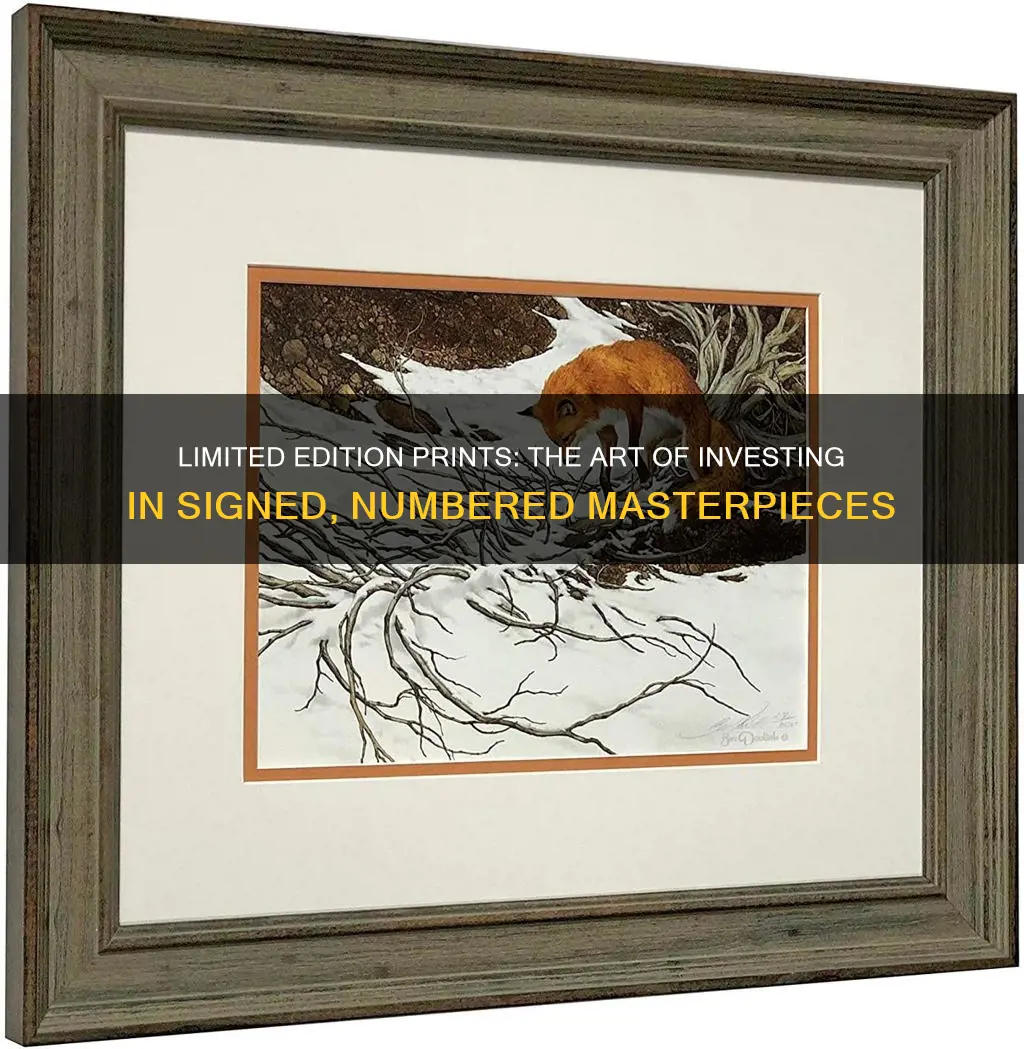
Investing in art is a great way to diversify your portfolio. Prints are an excellent way for art enthusiasts to start an art collection. They are easy to store, affordable, created in various styles and available in numerous sizes. Limited-edition prints are particularly valuable because they are in high demand and typically retain or increase their value over time.
When buying limited-edition prints, it is important to understand what drives their value. The most valuable prints are usually the lowest numbers of small sets. The first print is often the most valuable as it is the closest to the artist's original idea. Artist or printer proof versions are also deemed rare and likely to hold more value. When considering the value of contemporary art, the artist is everything. The workmanship, materials, training and reputation of the artist must all be carefully considered.
| Characteristics | Values |
|---|---|
| Numbering | Indicates the print's position in the edition, e.g. 50/100. |
| Signature | Proves the artist's involvement and provides provenance. |
| Edition Size | Smaller editions are more valuable due to their exclusivity. |
| Artist | Prints by celebrated or esteemed artists are more valuable. |
| Print Condition | Pristine condition increases value. |
| Historical Significance | Prints linked to a specific era or cultural event may be more valuable. |
| Provenance | Prints with documented histories, including past owners and exhibitions, are more valuable. |
| Printing Quality | Fine craftsmanship, materials, and expertise increase value. |
| Paper & Ink | High-quality, long-lasting paper and ink increase value. |
| Age | Older prints can gain worth, especially if well-preserved. |
| Subject Matter | Images with broad appeal or significant messages are more valuable. |
| Framing & Presentation | A well-chosen frame can increase value. |
| Market Trends | Demand for a specific artist or style can impact value. |
What You'll Learn

The artist's reputation and the print's condition
The artist's reputation is a significant factor in determining the value of limited-edition prints. Prints by well-known artists with established careers are more likely to increase in value over time. Collectors are often willing to pay a premium for prints by highly regarded artists with a history of excellence. Therefore, it is advisable to research the artist's career trajectory and consult experts before investing in limited-edition prints.
In addition to the artist's reputation, the condition of the print also plays a crucial role in its value. Well-preserved prints that are free from damage, wear, discolouration, or harm are generally more valuable. This is due to the rarity and collector's desirability of prints in pristine condition. Before purchasing a print on the secondary market, it is recommended to request a condition report from the seller to assess any damage and determine its value accurately.
When investing in limited-edition prints, it is essential to carefully consider the artist's reputation and the print's condition. By choosing prints by established and reputable artists and ensuring the prints are in excellent condition, you can maximise the potential for the artwork to appreciate in value over time.
Retirement Investing: Why the Wait?
You may want to see also

Rarity and edition size
The first prints in an edition are often the most valuable as they are considered closest to the artist's original idea. The lower the number, the higher the value. For example, the first print in an edition of 100, 1/100, will be worth more than the fiftieth print, 50/100. These early prints are also usually in better condition as the printing plates or screens are fresh and less worn, allowing for more faithful reproductions of the original artwork.
Prints in limited editions, with only a few in existence, are more valuable than mass-produced or open editions. The latter have no limit on the number of prints produced and are generally cheaper to buy, but they are less likely to increase in value.
It is important to note that the number of a print does not usually affect its resale value. This is because each impression in a limited edition is largely identical, with only minor differences. However, when galleries sell limited-edition artworks for the first time, they often sell them in number order, increasing the price of the remaining works as demand grows. In this case, the last print sold, e.g. 30/30, will be more expensive than the first print sold, e.g. 1/30.
Limited editions can be used as an art investment, bought and then resold once their price rises due to their rarity and demand. A publisher may also incrementally increase the price of a print as the edition sells and the remaining prints become scarcer.
Pay Off the House or Invest: The Barefoot Investor's Guide to Financial Freedom
You may want to see also

Historical significance
For instance, prints from the Pop Art era of the 1960s remain highly sought after and command high prices at auctions. This era witnessed a transformative shift in the art world, with artists like Andy Warhol challenging traditional notions of art and embracing mass production and consumer culture. Warhol's decision to sell trial proofs, unique prints that showcase the artist's experimentation with colours and compositions, was a significant departure from the norm and added to their collectability.
Additionally, the early history of printmaking, with its technical limitations, influenced the perceived value of printed images. The first prints from wood or copper surfaces were of better quality, and printmakers numbered their works to reflect this, knowing that subsequent prints would be of lower quality. This practice of numbering, along with signatures, became a way to indicate authenticity, scarcity, and proximity to the artist's original vision, all of which contribute to a print's historical significance and, consequently, its value.
Moreover, the tax system in the UK once reinforced the higher status of low-numbered editions by imposing a 33% purchase tax on editions with more than 75 prints. This further elevated the value of limited editions with lower numbers.
Today, while new printmaking techniques have eliminated quality differences between lower and higher numbers in an edition, the historical context surrounding early printmaking continues to shape the perception and value of limited-edition prints.
REITs: Why Aren't More People Investing?
You may want to see also

Printing quality
Printing Techniques:
The choice of printing technique can vary depending on the artist's preferences and the desired outcome. Traditional printmaking techniques such as etching, lithography, screen printing, or woodblock printing were commonly used in the past. These techniques produced limited editions due to the gradual wear and tear of the plates or blocks used for printing. With technological advancements, artists now have the option to use digital printing methods like giclée printing, which offers high-quality reproductions using inkjet printers and archival materials.
Paper and Ink:
Consistency in paper and ink quality is essential for maintaining printing quality. Artists should use the same type of paper and ink throughout the limited edition to ensure uniformity across the prints. This consistency ensures that each print in the edition has the same colour fidelity, texture, and longevity.
Printing Consistency:
Limited-edition prints should be printed using the same printer, preferably owned by the artist, to maintain consistency. This helps ensure that each print has identical characteristics and that there are no variations in colour, contrast, or sharpness. Consistency in printing contributes to the overall quality and value of the edition.
Printing on Demand:
The flexibility of printing on demand is an advantage offered by digital printing technology. Artists can manage their inventory more effectively and respond to market demand by printing their limited editions as orders come in. This approach allows artists to control their work better and avoid overprinting, reducing costs.
Artist Proofs:
Artist proofs, or test prints, are often created before the final limited edition to ensure printing quality. These proofs are typically retained by the artist and sold separately, sometimes at a higher price. Artist proofs are considered even rarer than the limited-edition prints and are highly valued by collectors.
Certificates of Authenticity:
Along with printing quality, providing certificates of authenticity is essential for limited-edition prints. These certificates enhance the credibility of the artwork and assure collectors of its authenticity. They should include details such as the artist's name, title of the work, print number, edition size, printing process, and materials used.
Retirement Planning: Your Future, Your Wealth
You may want to see also

Age
The age of a print can be an important factor in determining its value. Older prints can gain worth over time, especially if they are well-maintained. However, it is crucial to remember that not all aged prints are valuable; the artist's reputation and the print's condition are also significant factors.
The printing date of a limited-edition print can be crucial in determining its value. Do not assume that a print is worth more just because it appears old. Mass-produced reproductions of older works do not hold the same value as authentic fine art printmaking, which is a deliberate creative process performed by the artist or under their instruction.
The more labor-intensive the printing process, the more valuable the resulting print might be. For instance, multi-colour works tend to be more valuable than black-and-white works because they take longer to produce. Large prints also tend to be more expensive because they require a large printing press and the assistance of a master printmaker.
The age of a print can be determined by researching the artist and the specific printing process used. The earliest examples of etchings are from the Middle Ages, and the earliest signed and dated etching was created by Urs Graf in 1513. The method of etching became most popular in the 17th and 18th centuries when artists such as Rembrandt and Piranesi expanded and popularised the art form.
When investing in limited-edition prints, it is essential to research and consider the age of the print, the artist's reputation, the condition of the print, and the printing process used.
Rethink Robotics: Investors' Vision
You may want to see also
Frequently asked questions
The value of limited-edition prints is influenced by several factors, including the artist's reputation, the rarity and edition size, the condition of the print, historical significance, printing quality, and market trends. The lower the number in the edition, such as 1/100 compared to 50/100, the more valuable it tends to be due to its exclusivity and being closer to the original.
Limited-edition prints are usually numbered at the bottom right corner of the print. The number represents a fraction, where the bottom number indicates the total number of prints in the edition, and the upper number shows the order in which each print was made. For example, 33/150 means it is the 33rd print out of 150 prints.
Limited-edition prints are valuable for investment because they are in high demand and typically have a higher residual value than non-tangible assets. The limited supply increases demand, and their value tends to retain or increase over time, especially if the artist's popularity grows.
Limited-edition prints can be found at art galleries, art auctions, and art fairs. Art galleries offer a wide range of established and up-and-coming artists, while art auctions and fairs may provide competitive pricing but involve bidding against other buyers.







